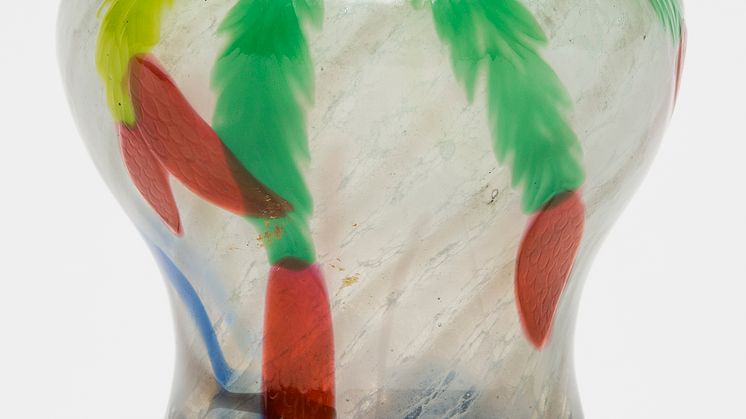
Press release -
New acquisition: Technically advanced Art Nouveau glass vase by Betzy Ählström
Nationalmuseum has acquired a unique piece of art glass designed by Betzy Ählström. The Christmas Cactus vase was manufactured in 1902 at the Reijmyre glassworks where she was hired for a brief period. Ählström is now considered one of the female pioneers in the history of Swedish glassmaking and only a few works by her are known.
The vase represents an important addition to Nationalmuseum’s art glass collection, and specifically to the group of glass pieces dating from the early 20th-century Art Nouveau period. This period had long been represented solely by the works of male designers. Over the past two decades, Nationalmuseum has made several attempts to add pieces by female designers of the time. Although their contribution was not large in quantity, in quality terms their work was at least as interesting as that of their male contemporaries.
Ahead of the 1902 Turin International Exhibition of Modern Decorative Art, the Reijmyre glassworks turned its attention to technically advanced art glass. The company hired Betzy Ählström (1857–1934), a drawing teacher from Gothenburg, who served as in-house designer for a brief period in 1901–02, working exclusively on art glass. The Reijmyre pieces designed by Ählström were hailed as brilliant by the international press at the 1902 exhibition. Between 10 and 15 works by Ählström are known to still exist today.
The glassworks opted for an elaborate technique inspired by the French art glass known as marqueterie de verre. While still hot, the piece is rolled in crushed glass and then reheated. Further decoration in the form of glass offcuts can then be added to enhance the effect. Reijmyre was fortunate to employ a highly accomplished glassblower, Fredric Kessmeier (1859–1946), who had the skills to turn design ideas into finished pieces. With this technique, the crucial parts of the process occur while the glass is hot, which calls for close collaboration between artist and glassblower on the shop floor. Betzy Ählström pioneered this kind of working relationship in Sweden, which became the norm for later generations of glass artists as the 20th century progressed.
After the 1902 exhibition, Reijmyre ceased production using this technique on cost grounds, and Betzy Ählström faded into obscurity. In 1951, the estate of King Gustaf V donated to Nationalmuseum a small, unremarkable vase (NMK 11/1951), bearing the signature “Reijmyre No 8”, which had belonged to the late king’s consort, Queen Victoria. At the time, the designer of the piece could not be identified. It was not until 1980, when Nationalmuseum staged an exhibition of Swedish Art Nouveau glass, that the unknown designer Betzy Ählström was rediscovered.
Nationalmuseum’s purchase of this vase was made possible by a generous donation from the Anna and Ferdinand Boberg Foundation, established in 1946 to manage the funds bequeathed by Mr and Mrs Boberg. Nationalmuseum has no budget of its own for new acquisitions, but relies on gifting and financial support from private funds and foundations to enhance its collections of fine art and craft.
Press contacts
Micael Ernstell, Curator, Applied Art and Design, micael.ernstell@nationalmuseum.se, +46 8 5195 4392
Hanna Tottmar, Press Officer, hanna.tottmar@nationalmuseum.se, +46 767 234632
Caption
Betzy Ählström, Christmas Cactus vase, 1902. Photo: Linn Ahlgren/Nationalmuseum.
Categories
Nationalmuseum is Sweden’s premier museum of art and design. The collections comprise older paintings, sculpture, drawings and graphic art, and applied art and design up to the present day. The museum building is currently under renovation and scheduled to open again in 2018. In the meantime, the museum will continue its activities through collaborations both in Sweden and abroad as well as temporary exhibitions at the Royal Swedish Academy of Fine Arts, Fredsgatan 12 and Nationalmuseum Design at Kulturhuset Stadsteatern in Stockholm. Nationalmuseum has partnerships with Svenska Dagbladet and the Grand Hôtel Stockholm, and acknowledges the support of FCB Fältman & Malmén.

